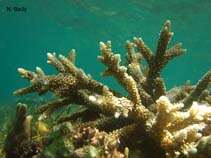Acropora formosa (Dana, 1846)
Warning: DOMDocument::load(): SSL operation failed with code 1. OpenSSL Error messages: error:140770FC:SSL routines:SSL23_GET_SERVER_HELLO:unknown protocol in C:\Apache24\htdocs\includes\SpeciesSummary.lib.php on line 1236
Warning: DOMDocument::load(): Failed to enable crypto in C:\Apache24\htdocs\includes\SpeciesSummary.lib.php on line 1236
Warning: DOMDocument::load(https://sealifebase.nrm.se/webservice/AquaMaps/getAMap.php?genus=Acropora&species=formosa): failed to open stream: operation failed in C:\Apache24\htdocs\includes\SpeciesSummary.lib.php on line 1236
Warning: DOMDocument::load(): I/O warning : failed to load external entity "https://sealifebase.nrm.se/webservice/AquaMaps/getAMap.php?genus=Acropora&species=formosa" in C:\Apache24\htdocs\includes\SpeciesSummary.lib.php on line 1236
Classification / Names Common names | Synonyms | CoL | ITIS | WoRMS
| Scleractinia | Acroporidae
Environment: milieu / climate zone / depth range / distribution range Ekologi
Revassocierade; djupintervall 0 - 25 m (Ref. 8294). Tropical; 30°N - 34°S, 27°E - 135°W (Ref. 846)
Utbredning Länder | FAO områden | Ekosystem | Förekomster | Utplanteringar
Indo-Pacific. Tropical and subtropical.
Length at first maturity / Size / Vikt / Age
Maturity: Lm ? range ? - ? cm Max length : 49.0 cm COLD hane/ej könsbestämd; (Ref. 269); common length : 49.0 cm hane/ej könsbestämd; (Ref. 269)
Short description Morfologi
This is the classic "staghorn coral", with aborescent growth form and branches usually less than 50 cm in length. Colonies are composed of smooth appearing, straight branches less than 2 cm thick; branching is irregular such that colonies from thickets which often dominate large areas of lagoon in shallow and intermediate depths (Ref. 269).
Depth based from occurrence record (Ref. 8294); to be replaced with a better reference. Dominates large areas of lagoon in shallow and intermediate depths (Ref. 269). Has high bleaching level and high estimated mortality in Palau (Ref. 66144).
Life cycle and mating behavior Könsmognad | Reproduktion | Lek | Ägg | Fecundity | Larver
Hermaphroditic (Ref. 113712). Mature gametes are shed into the coelenteron and spawned through the mouth. Life cycle: The zygote develops into a planktonic planula larva. Metamorphosis begins with early morphogenesis of tentacles, septa and pharynx before larval settlement on the aboral end (Ref. 833).
Main reference
referenser | Koordinator | Medarbetare
Hodgson, G. 1998. (Ref. 269)
IUCN Red List Status (Ref. 130435)
Near Threatened (NT) ; Date assessed: 03 January 2008
CITES status (Ref. 108899)
Appendix II: International trade monitored
CMS (Ref. 116361)
Not Evaluated
Threat to humans
Human uses
| FishSource |
Verktyg
Ytterligare information
Internet-källor
BHL | BOLD Systems | CISTI | DiscoverLife | FAO(Publication : search) | Fishipedia | GenBank (genome, nucleotide) | GloBI | Gomexsi | Google Books | Google Scholar | Google | PubMed | Hexacorallians of the World | Tree of Life | Wikipedia (Go, sök) | Zoological Record
Estimates based on models
Preferred temperature
(Ref. 115969): 24.8 - 29.3, mean 28.4 (based on 3503 cells).
Price category
(Ref. 80766):
Unknown.



